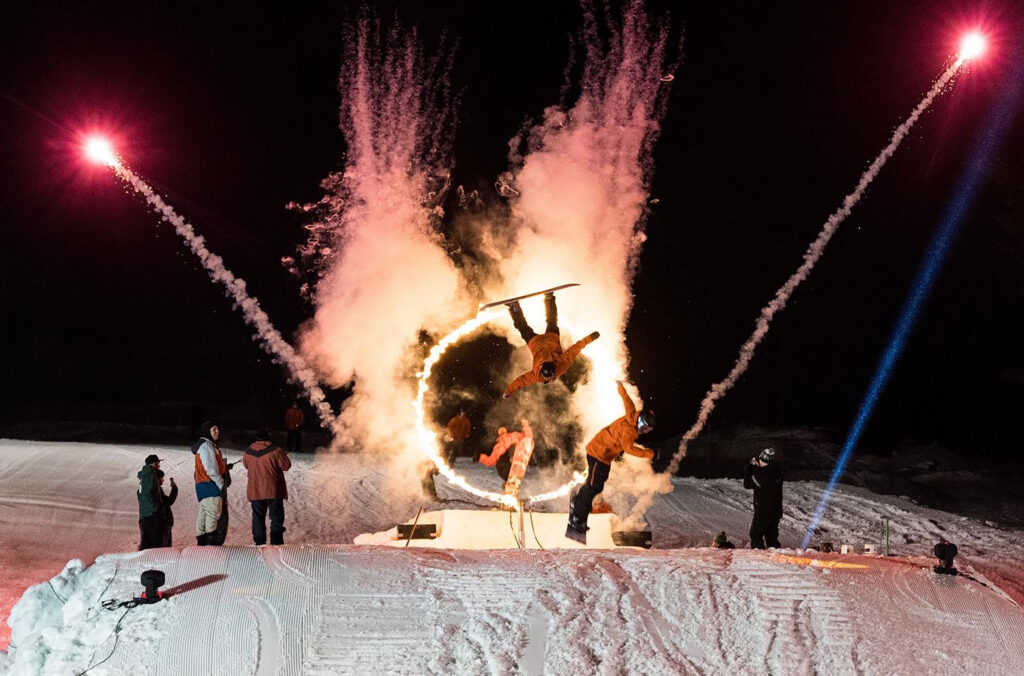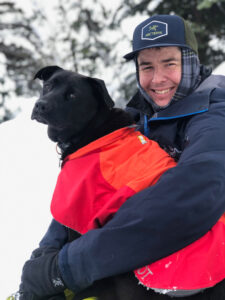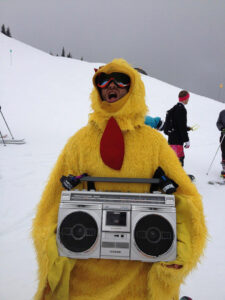Whistler Blackcomb’s legendary Fire & Ice Show has matured since its inception with this season’s production marking 26 years. What started as a somewhat loose affair run by the Whistler Blackcomb’s ski school, the free winter spectacle became well known during the 2010 Olympic and Paralympic Games as part of the nightly medal ceremonies, where big-name bands like Swollen Members and Chromeo performed at the base of the jump in Skier’s Plaza.
In 2024, Fire & Ice spectators will experience an audio opening that speaks to the volcanoes and glaciers that shaped the Whistler Valley, as well as the legend of Spo7ez, a village shared by the Squamish Nation and the Lil’wat Nation. The Spo7ez Performance Team follow the audio opening with a welcome song.
The finale features dance performances by world champion hoop dancer Alex Wells, and his family at Native Thunder Productions, as well as signature fireworks.
Throughout the evening MCs and DJ PRAIZ bring the hype for a dedicated group of athletes who love their job. I chatted to three of them about what makes Whistler’s Fire & Ice spectacle so unique.
Meet the Fire & Ice Show Athletes
Originally from Spain, Operations Manager Mauro Nunez has seen it all. He started as an athlete in the first season of Fire & Ice and has filled many roles over the years. These days, as well as making sure everything runs smoothly, he is responsible for choosing the team of athletes.
So what does it take to be an athlete on the Fire & Ice team?
“Experience and air awareness,” says Mauro. “Not everyone is designed for this jump because there are so many factors; you have to watch out for the rain, you can’t carve super hard, the landing might be short, and you have to be comfortable jumping at night and in smoke from the fireworks.”
For the newest member of the team, Mikey Barton, being a part of Fire & Ice is something he’s dreamed about since he was nineteen years old.
“I remember when I first moved to Whistler, like 14 years ago, and seeing Mauro do it. I remember looking at it and thinking; that looks so fun! I wish I could do that one day.”
A Vancouver local and member of the Nishga’a nation, Mikey first got into snowboarding through a program called Burton Chill.
“Burton has this cool thing they do where they give you a day on the mountain with coaching, and that got me into snowboarding.”
He continued snowboarding with the First Nations Snowboarding Team, now known as Indigenous Life Sport Academy (ILSA), before becoming a coach in 2011. He’s currently ILSA’s Skateboard Manager and Head Snowboard Coach.

Knowing that you have to hit that jump consistently, how do you prepare yourself for the show?
“I just snowboard as much as I possibly can all the time,” says Mikey. “I come up and coach ILSA during the day on Sunday. I coach kids throughout the day, have a couple of hours off and then do the show. That was the Sunday routine for a little while and that was super fun.”
After sixteen years with Fire & Ice, veteran athlete and full-time Arc’teryx employee Jesse Robson doesn’t spend as much time on his skis as he used to.
Has your Fire & Ice Show preparation changed over the years?
“The biggest thing that I do [now] is make sure that I’m fit and strong,” explains Jesse. “So in the city, I do a lot of CrossFit and stretching. Going into the season this year we did some water ramps with the other jumpers and that was a really good refresher, but a lot of it is just staying fit and getting time on the skis. At the same time, I’ve been doing it for long enough that I have my regular routine.”
Despite having a regular routine, the changing nature of the jump means that all of the freestyle skiers and snowboarders need a few runs to warm up before the show each week.
The jump gets built up from scratch every Sunday afternoon, is it always the same?
“The jump is always about the same length,” says Mauro. “We’ve gone between 28 and 40 feet this year. It just depends on what kind of snow you can get on the landing. You always want a landing to be steep, but if it’s really steep then it’s short, so you have to find a good angle and the takeoff has to match. So, it depends on the snow and the personality of the driver.”
The image of skiers and snowboarders launching themselves through a ring of fire and into the night sky is one that definitely draws a crowd.
How does it feel to perform in front of a big audience?
“It’s so sick,” says Mikey. “I’ve done other smaller events, but there’s nothing like a crowd that big. It’s really cool to have everyone just watching that one jump. And you can hear them too.”
“It’s definitely something else,” says Jesse. “You’re standing up there and there’s five to ten thousand people sometimes, like on our New Year’s shows when it’s packed out completely, and it’s a lot of fun. Everyone gets pretty amped up when there are big crowds and the crowd’s into it.”

Has anyone ever hit the ring of fire?
“Yep. It’s happened a couple of times over the years for various reasons,” explains Jesse. “Mostly from getting caught up on the in-run. I’ve hit it with my pole a couple of times, but you don’t really notice it.”
What makes Whistler’s Fire & Ice show so unique?
“It’s the only thing like it in town really,” says Mauro. “There’s lots of people that come back and they’re like; oh we haven’t seen the show in years, but it’s cool that it’s still going. The show’s also become so much more inclusive.”
“It’s really good to see the direction things are going,” says Jesse. “The connection with the Squamish Nation and Lil’wat Nation, and the professionalism and focus on the production side has been quite exciting. It’s always been fun, but it’s at a totally different level to what it was when I first started.”
“The integration of the cultural dancing is really sweet,” says Mikey. “I’m Indigenous so I’ve grown up going to powwows my whole life. Me and my Mom used to sell bannock at them, we still do. I just love being around the music, that environment and Indigenous culture.”
You can watch the Fire & Ice Show every Sunday at 7:30 PM at Skier’s Plaza (base of Whistler Mountain), throughout the winter season. Make sure to dress warmly and wear sturdy waterproof boots, as the best views are from the bottom of the snowpack.
Book your next winter trip to Whistler now to secure the biggest savings of the season, with up to 65% off lift tickets and 40% off rentals. Stay longer, save more; book seven nights or more and receive a free $100 CAD Dining Voucher. Sign up to be a Rewards by Whistler.com Member and receive a FREE $50 CAD activity voucher on stays of 3+ nights.
Epic Coverage is included for free with the purchase of a day or season pass, so you can plan ahead with peace of mind.
Come experience Whistler Blackcomb’s extensive terrain and adventure at every turn to see why we're known as one of the best resorts on the planet. Secure your mountain getaway with Whistler.com for personalized service and the local knowledge of our Whistler-based team.





